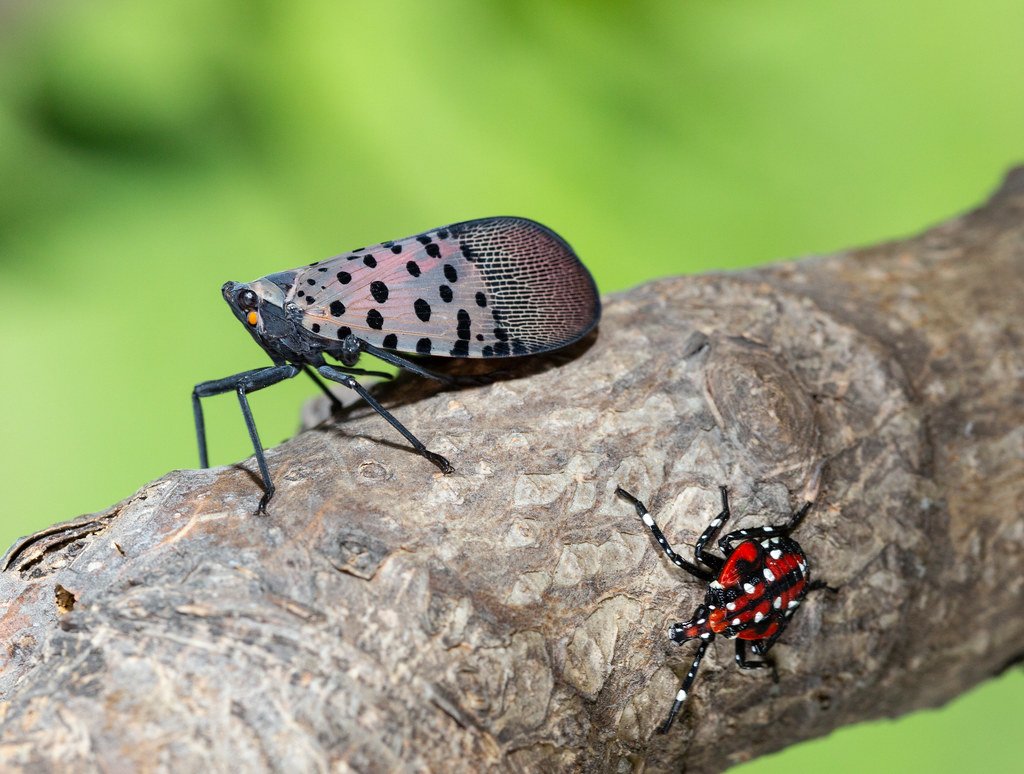Spotted Lanternfly Puts Hudson Valley Vineyards on High Alert
Two spotted Lanternflies resting on a tree trunk (left to right): Adult Lanternfly and Nymph in 4th Instar. Source: Flicker, Photo by Stephen Ausmus licensed under the USDA-ARS
The spotted lanternfly– one of the most unwanted insects of the summer– has invaded parts of New York and is gorging its way up to the Hudson Valley.
While not venomous or harmful to humans, the insects are mendacious to over 70 plant species because of the damage they leave behind. When the insects feed on grapevines, birch trees or trees-of-heaven by sucking out the sap from their stems, leaves and trunks of trees, they excrete honeydew – a sticky and sugary residue – from their backside that encourages sooty mold growth. As plants become covered with mold, their access to sunlight is inhibited, which reduces the one process plants need for survival–photosynthesis.
Attracted to phloem sap, these planthoppers latch their bodies to trees and pierce their mouthparts into the trunks of trees and ingest large quantities of the sugary food. When nutrients are extracted from the sap and processed in their bodies, the insects leave the honeydew as a waste product. This waste dribbles down from the tree tops and sticks to anything down below such as foliage, crops and outdoor furniture. The sticky mess left behind can attract other unwanted insects like ants, wasps and bees.
“Spotted lanternfly is a nuisance pest to home-owners,” Julie Urban, Senior Research Associate of Entomology at Penn State University, said in a 2019 paper. “High levels of sooty mold growing on honeydew visibly blackens trees, understory plants, decking [and] lawn furniture.”
The spotted lanternfly distribution map as of Aug. 18, 2022. Source: New York State Integrated Pest Management
After a stone shipment containing egg masses was shipped from China to Berks County, Pennsylvania in 2012, the insect began accumulating itself in the area and was first identified in the U.S. in 2014. Since then, the invasive species has invaded parts of the Mid-Atlantic, Northeast and Midwest.
The planthopper has made an appearance in the areas of the lower Hudson Valley in 2020 like in Sloatsburg, Orangeburg and Port Jervis, but because of their ability to easily hitchhike onto nearby cars, people and animals, they are continuing to spread.
Abundant in suburban and urban areas, these voracious feeders have the potential to damage the U.S. grape production industry, which is valued at 5.5 billion dollars.
“The presence of the spotted lantern fly (SLF) has all vineyards on high alert as this has the potential to cause significant damage to vineyards in a short period of time,” said Dan Heavens, the owner of the Nightingale Farm and Quartz Rock Vineyard. “At Nightingale Farm, we have increased our vineyard scouting in an effort to stay ahead of any invasion or potential invasion. This includes scouting nearby wooded areas as these areas have a higher potential for possible invasion.”
The gray four-winged and black polka dotted insect has not been detected at Millbrook Vineyards, Vice President and General Manager David Bova said, but the invasive insect has been spotted in the highland area, which Heavens says has Nightingale farm anxious about potential damage.
States with high spotted lanternfly populations are utilizing various methods to attack this problem and prevent adults from laying eggs between September and November. Penn State Extension suggests destroying egg masses, trapping adults, eliminating popular host trees or even using insecticides.
Insecticides – approved by the Environmental Protection Agency (EPA) – containing imidacloprid or dinotefuran have proven to help protect trees from SLFs. However, each insecticide is different and is registered for specific uses on certain crops such as grapes.
Trees-of-heavens, like spotted lanternflies, are native to China and are the favorite deciduous tree of these insects. Spotted lanternflies love these trees because of their readily available food that allow them to multiply and gorge on the nutrients. These trees have been located in areas of Philadelphia and even the Lenoir Preserve in Yonkers, New York.
The New York State Department of Environmental Conservation (DEC) says “New York's annual yield of apples and grapes has a combined value of $358.4 million, which could be greatly impacted by SLF. The full extent of economic damage this insect could cause is unknown at this time.”
Some of the counties used for monitoring and testing to detect spotted lanternflies early by the DEC include Dutchess, Orange and Westchester.
“If you’ve spent any time in an area infested with spotted lanternfly it is important to check for egg masses, adults, and nymphs on your vehicle and any other items you may be transporting,” says the New York State Integrated Pest Management.

